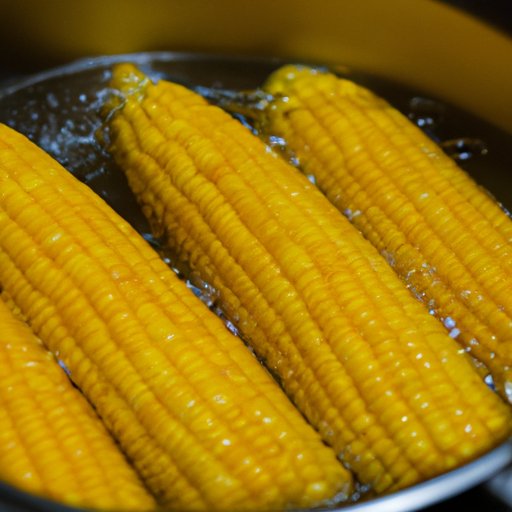Introduction
Boiling corn seems simple enough, but many people struggle with achieving the perfect texture and flavor. You may have experienced corn that is too tough, too mushy, or just not flavorful enough. If you want to master the art of boiling corn, you’ve come to the right place. In this guide, we’ll provide you with step-by-step instructions and other tips to cook corn on the cob perfectly every time.
A Beginner’s Guide to Boiling Corn: Step-by-Step Instructions
Before you start boiling your corn, there are a few preparation steps that you need to take care of:
1. Clean the corn: Rinse the corn under running water to remove any dirt and debris.
2. Remove the husk and silk: Peel back the husk and remove the silk threads. Cut off the stem end if necessary.
Now that you’ve prepared the corn, it’s time to start boiling:
1. Boil the water: Fill a large pot with enough water to cover the corn. Bring the water to a rolling boil over high heat.
2. Add the corn to the pot: Gently place the corn in the boiling water using tongs. Avoid overcrowding the pot.
3. Boil the corn: Cook the corn for 5-7 minutes, depending on the size and freshness of the corn. Don’t overcook the corn or it will become tough.
4. Drain the corn: Use tongs to remove the corn from the pot and let it cool down on a cutting board for a few minutes.
The Perfect Corn on the Cob: Tips and Tricks for Boiling
If you want to take your boiled corn to the next level, here are some tips and tricks to consider:
1. Selecting the right corn: Choose fresh, plump ears of corn with bright green husks and brown, slightly sticky tassels. Avoid corn with shriveled or dry kernels.
2. Using salt and sugar in boiling water: Add a tablespoon of salt and a tablespoon of sugar to the boiling water. This will enhance the natural sweetness of the corn and make it more flavorful.
3. Adding butter to the water: Some people like to add a few tablespoons of butter to the boiling water to make the corn taste richer and creamier. You can also rub a stick of butter on the corn after it’s cooked.
4. How to test if the corn is done: Gently press a kernel with your fingernail. If it pops, the corn is done cooking. Alternatively, you can use a knife to check the kernel color, which should be yellow and plump.
5. Letting the corn rest: After boiling, let the corn rest for a few minutes to allow the flavors to settle. Cover the corn with a clean towel to keep it warm.
5 Mistakes to Avoid When Boiling Corn
Don’t make these common mistakes that can ruin your boiled corn:
1. Overcooking the corn: Overcooked corn becomes tough and loses its texture.
2. Adding the corn too early: Wait until the water is boiling before adding the corn, or the kernels may become mushy.
3. Using too much or too little water: Use just enough water to cover the corn and don’t overcrowd the pot.
4. Not shucking the corn properly: Make sure to remove the husk and silk completely before boiling.
5. Not salting the water: Adding salt to the boiling water is crucial for flavoring the corn.
How Long Should You Boil Corn?: A Comprehensive Guide
There’s no one-size-fits-all answer to this question, as boiling time depends on several factors:
1. Factors that affect boiling time: The age of the corn, the size of the kernels, and the freshness of the corn can impact boiling time. Generally, the fresher the corn, the less time it needs to boil.
2. Standard boiling time: Most corn on the cob needs to boil for 5-7 minutes, but larger ears may need 8-10 minutes.
3. Testing if the corn is ready: There are two common methods to test if the corn is done: pressing a kernel with your fingernail or checking the color and texture of the kernels.
Creative Additions to Your Boiled Corn: Spices, Sauces, and Butters
If you want to experiment with new flavors, here are some ideas to get you started:
1. Adding spices: Sprinkle your boiled corn with spices like paprika, cumin, garlic powder, or chili powder to add a kick of flavor.
2. Making flavored butters: Mix softened butter with herbs, spices, or grated cheese to create a delicious spread for your corn.
3. Using different sauces: Drizzle your corn with a flavorful sauce like mustard, hot sauce, or barbecue sauce.
A Comparison of Boiling vs. Grilling Corn: Which is Better?
Boiling and grilling are two popular methods to cook corn on the cob. Here’s a comparison of the pros and cons of each:
1. Pros and cons of boiling corn: Boiling is a simple and quick method to cook corn, and it’s great for large quantities. However, it may not add as much flavor as grilling, and the texture can be too soft for some people.
2. Pros and cons of grilling corn: Grilling gives corn a smoky flavor and crispy texture, and it’s perfect for outdoor gatherings. However, it requires more time and effort than boiling and can be challenging for beginners.
3. Which method is better for specific situations: Boiling is best for quick, simple meals, while grilling is better for special occasions and outdoor gatherings.
Conclusion
Now that you know how to boil corn like a pro, it’s time to start cooking! Remember to choose fresh corn, salt the water, avoid overcooking, and experiment with new flavors. Whether you prefer your corn plain or with a drizzle of hot sauce, boiled corn is a classic summer dish that never gets old.
